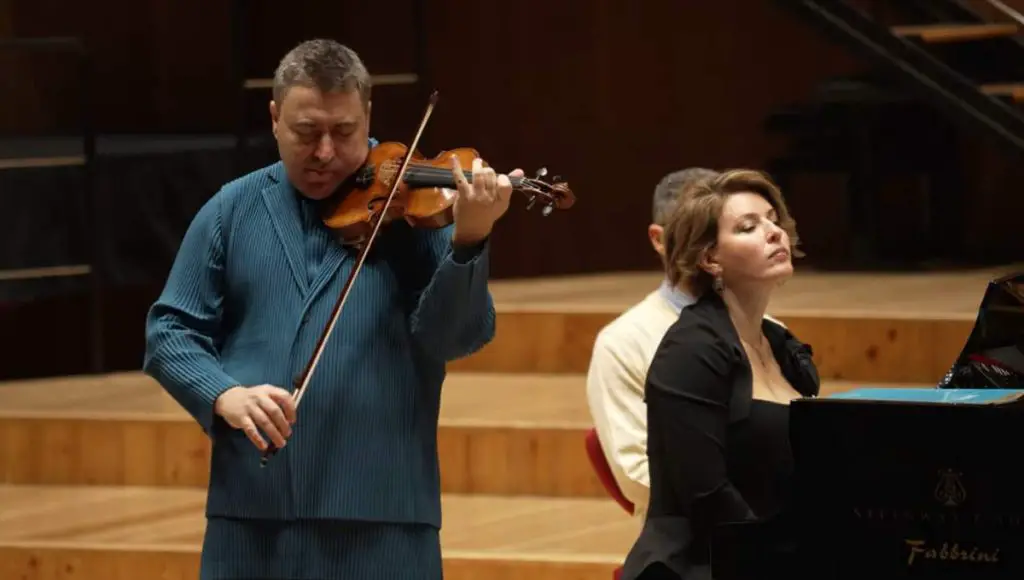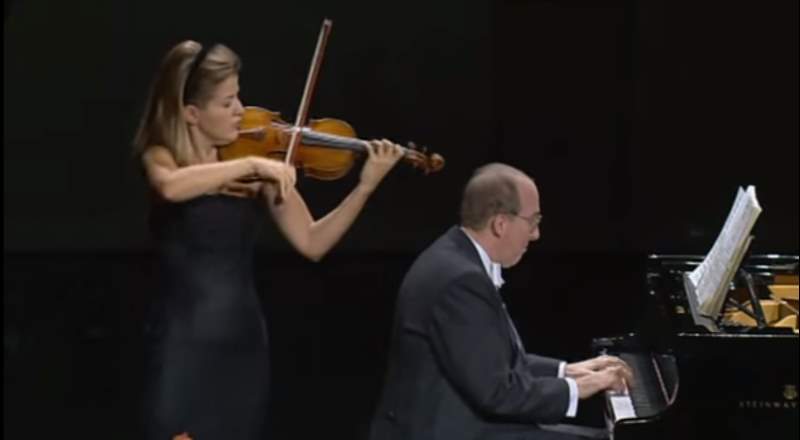Russian classical pianist Polina Osetinskaya and Soviet-born Israeli violinist Maxim Vengerov perform Ludwig Van Beethoven’s Violin Sonata No. 9, Op. 47 in A major, commonly known as the Kreutzer Sonata. Recorded at Sala Verdi, Milano, on November 15, 2022. It is an 1803 sonata for piano and violin notable for its technical difficulty. The piece was nicknamed the Kreutzer Sonata (German: Kreutzer-Sonate) after the French violinist Rodolphe Kreutzer (15 November 1766 – 6 January 1831). But, Kreutzer actually disliked the piece and never played it.
Ludwig Van Beethoven’s Kreutzer Sonata
Originally, the sonata was dedicated to George Bridgetower (1778-1860), the British violinist of African descent, and titled “Sonata mulattica composta per il mulatto Brischdauer [Bridgetower], gran pazzo e compositore mulattico” (Mulatto Sonata composed for the mulatto Brischdauer, great madman mulatto composer).
Bridgetower visited Vienna in 1803, where he performed with Ludwig van Beethoven. Beethoven was impressed with his talent and thus dedicated his Violin Sonata No. 9 to him.
On May 24th, 1803, shortly after its completion, Bridgetower and Beethoven premiered the work at the Augarten Theatre during an unusually early 8:00 am concert. Despite never having seen the piece before and there being no time for rehearsal, Bridgetower sight-read the sonata.

However, following the premiere, Beethoven and Bridgetower had a falling out. During a drinking session, Bridgetower insulted the morality of a woman whom Beethoven deeply cared for. This angered Beethoven, causing him to revoke the piece’s dedication to Bridgetower and instead dedicate it to the French violinist Rodolphe Kreutzer (15 November 1766 – 6 January 1831), who was widely regarded as the greatest violinist of the time.
However, Kreutzer actually disliked the piece and never played it, thinking the sonata was “outrageously unintelligible”. He did not particularly care for any of Beethoven’s music, and they only ever met once, briefly.

The piece is in three movements. With start times in the video:
- 00.06 Adagio sostenuto – Presto (A major – A minor, sonata form). The sonata opens with a slow 18-bar introduction, of which only the first four bars of the solo violin are in the A-Major-key. The piano enters, and the harmony begins to turn darker towards the minor key until the main body of the movement – an angry A-minor Presto- begins. Here, the piano part matches the violin in terms of difficulty. Near the end, Beethoven brings back part of the opening Adagio, before closing the movement in an anguished coda.
- 14:15 Andante con variazioni (F major, variation form, with the third variation in F minor). There could hardly be a greater contrast with the second movement, a placid tune in F major followed by five distinctive variations. The first variation transliterates the theme into a lively triple meter while embellishing it with trills, while in the second the violin steals the melody and enlivens it even further. The third variation, in F minor, returns to a darker and more meditative state. The fourth variation recalls the first and second variations with its light, ornamental, and airy feel. The fifth and final variation, the longest, caps the movement with a slower and more dramatic feel, nevertheless returning to the carefree F major.
- Presto (A major, sonata form). In the finale of Beethoven’s Kreutzer Sonata, the calm is broken by a crashing A major chord in the piano, ushering in the virtuosic and exuberant third movement, a 6/8 tarantella in sonata form. After moving through a series of slightly contrasting episodes, the theme returns for the last time, and the work ends jubilantly in a rush of A major.
Polina Osetinskaya
Internationally acclaimed pianist Polina Osetinskaya began her career at the age of five and was soon acclaimed as a wunderkind in the former Soviet Union. She gave her first concert at the age of six and entered the Central Music School of the Moscow Conservatory at the age of seven.
The first teacher of Ms. Osetinskaya was her father Oleg Osetinsky, then she continued her studies at the Leningrad Conservatory with Marina Wolf and later at the Moscow Conservatory with Vera Gornostaeva.

Ms. Osetinskaya has performed at Carnegie Hall, Vienna’s Musikverein, London’s Barbican Centre, Rome’s Teatro Argentina, as well as in Russia, Germany, Poland, and Israel. She also appears at festivals in Europe, Russia, and the United States.
Osetinskaya immediately took to social media to publicly criticize Russia’s February 24 invasion of Ukraine, saying in an Instagram post that it was a “dark day” in the nation’s history.
She said she felt “horror, shame, and disgust.”
Because of this, her concerts are being canceled in her home country.
Maxim Vengerov
Maxim Vengerov is a world-renowned violinist and conductor who was born in Novosibirsk, Russia, on August 20, 1974. He began playing the violin at the age of five, and by the time he was ten years old, he had won his first national competition.
In 1990, Vengerov won the International Carl Flesch Violin Competition in London, which catapulted him to international stardom. He went on to win numerous other prestigious competitions, including the International Tchaikovsky Competition in Moscow in 1990 and the International Violin Competition of Indianapolis in 1991.
Vengerov has performed with many of the world’s leading orchestras, including the Berlin Philharmonic, the London Symphony Orchestra, and the New York Philharmonic, among others. He has also collaborated with some of the most celebrated conductors, such as Sir Simon Rattle, Claudio Abbado, and Daniel Barenboim.
In addition to his performing career, Vengerov is also a passionate educator and serves as a professor at the International Menuhin Music Academy in Switzerland. He has also been involved in various philanthropic projects, including the establishment of the Maxim Vengerov Foundation, which aims to support young musicians in their studies and performances.
Overall, Maxim Vengerov is recognized as one of the greatest violinists of our time, known for his virtuosity, musicianship, and expressive playing style.
Sources
- Violin Sonata No. 9 “The Kreutzer Sonata” (Beethoven) on Wikipedia
- Polina Osetinskaya’s official website
- Maxim Vengerov’s official website
- Maxim Vengerov on Wikipedia

